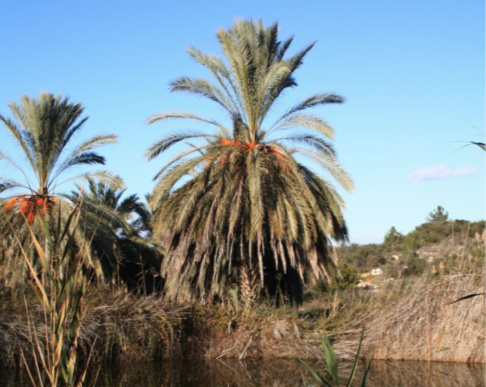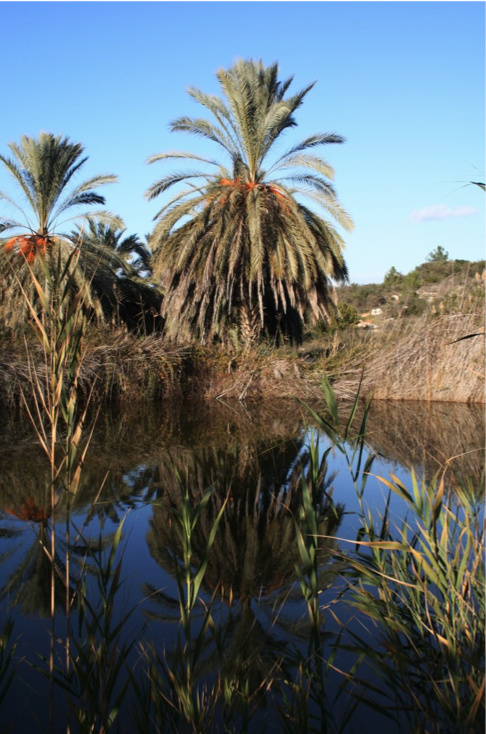
ALVIN JOHNSON says the ‘tamar’ or ‘tomah’, translated as the the date palm, is mentioned more than 50 times in the Bible…
The ‘tamar’ or ‘tomer’ is the date palm (Phoenix dactylifera). This tree grows to just over 20 metres in height and has long leaves (around four to fours metres). Date palms are dioecious, meaning they have separate male and female plants. The fruit is the date, which commonly are between three to seven centimetres long. When they are ripe they can range in colour from bright yellow to bright red. They turn their dark colour that most of us are familiar with, once they have dried.
There is evidence that dates have been a staple food in the Middle East for thousands of years. They were, and still are, very important trees.

Reflection of a date palm in a pool at Neot Kedumim in Israel. PICTURE: Alvin Johnson
One of the interesting aspects about the date palm is the length of time its seeds remain viable. One sprouted after being stored for 2,000 years! This seed was one of four found at the remains of Masada. It was a male Judean date tree, a species of date which became extinct about 1,000 years ago. It is now large enough to be used to fertilise existing female trees and although the new trees will be a hybrid of the Judean date palm, it is still providing a link to the flora of the past.
The tamar and tomer are both mentioned more than 50 times in the Scriptures.
In Exodus 15:27 (and Numbers 33:9) one of the stops on the wilderness journey of the Israelites was Elim; it was described as having “70 palm trees”.
The tamar was one of the four species that were to be used during the festival of Sukkot.
On the first day you are to take choice fruit from the trees, and tamar [palm] fronds, leafy branches and poplars, and rejoice before the Lord your God for seven days. Celebrate this as a festival to the Lord for seven days each year. – Leviticus 23:40-41
Jericho is referred to as the ‘city of palm trees’ in a number of passages including Deuteronomy 34:2: “[a]nd the South, and the Plain of the valley of Jericho the city of palm-trees, unto Zoar”.
See also II Chronicles 28:15 and possibly Judges 1:16 and 13:3, although this last reference might refer to another city.
In the book of Nehemiah, the returned exiles read from the Torah and they found the instructions to collect palm branches to make booths for the Festival of Sukkot.
‘Go out into the hill country and bring back branches from olive and wild olive trees, and from myrtle, tamar [palms] and shade trees, to make booths’ – as it is written. So the people went out and brought back branches and built themselves booths on their own roofs, in their courtyards, in the courts of the house of God and in the square by the Water Gate and the one by the Gate of Ephraim. – Nehemiah 8:15-16

Dates from Tunisia (Kebili) called Deglet. PICTURE: M Dhifallah (licensed under CC BY-SA 3.0)
The beauty of the tamar is referred to in the Song of Solomon 7:8:
How beautiful you are and how pleasing,
O love, with your delights!
Your stature is like that of the tamar [palm],
and your breasts like clusters of fruit.
I said, “I will climb the palm tree;
I will take hold of its fruit.”
May your breasts be like the clusters of the vine,
the fragrance of your breath like apples,
and your mouth like the best wine.
We rely on our readers to fund Sight's work - become a financial supporter today!
For more information, head to our Subscriber's page.
Psalm 92:12 promises that ‘the righteous will flourish like a tamar [palm] tree”.
The withering of the tamar is a call for repentance in Joel 1:12-14:
Despair, you farmers,
wail, you vine growers;
grieve for the wheat and the barley,
because the harvest of the field is destroyed.
The vine is dried up
and the fig tree is withered;
the pomegranate, the tamar [palm] and the apple tree –
all the trees of the field – are dried up.
Surely the joy of mankind
is withered away.
Put on sackcloth, O priests, and mourn;
wail, you who minister before the altar.
Come, spend the night in sackcloth,
you who minister before my God;
for the grain offerings and drink offerings
are withheld from the house of your God.
Declare a holy fast;
call a sacred assembly.
The judge Deborah held court under a tomer (palm) tree (Judges 4:5). The wooden doors of Solomon’s Temple were to have carvings of the date palm (I Kings 6:29,32).
In the New Testament, palm branches were spread out on the road in front of Jesus, as he rode a donkey into Jerusalem (John 12: 13): “They took palm branches and went out to meet him, shouting, ‘Hosanna!’ ‘Blessed is he who comes in the name of the Lord!’ ‘Blessed is the King of Israel!'”
Palm branches are also mentioned in Revelation 7:9-10:
After this I looked and there before me was a great multitude that no one could count, from every nation, tribe, people and language, standing before the throne and in front of the Lamb. They were wearing white robes and were holding palm branches in their hands. And they cried out in a loud voice:
‘Salvation belongs to our God,
who sits on the throne,
and to the Lamb.
This is an edited excerpt from Alvin Johnson’s iBook ‘Biblical Flora’, 2017. The book is available for free download on iTunes. A teacher’s edition is also available for purchase.





